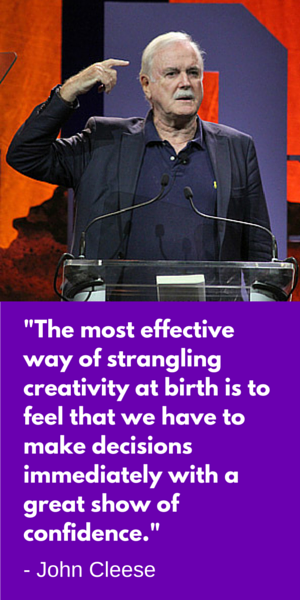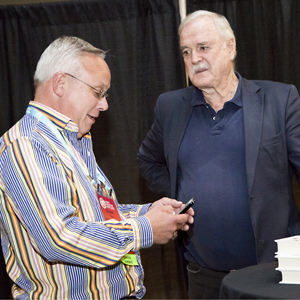In recent years, British comedic genius John Cleese has attracted a lot of attention for his speeches on creativity, in which he reflects on the early days of his career, and how he discovered the remarkable power of his subconscious mind to incubate and generate ideas.
Cleese has cultivated an eclectic career: In the late 1960s, he became a member of the Monty Python troupe. After that, he starred in a number of movies and co-wrote and performed in the British sitcom Fawlty Towers. More recently, he co-founded Video Arts, a firm that makes entertaining training films. The common theme throughout his varied career? Creativity.
I recently had an opportunity to hear Cleese give a keynote presentation on creativity at the Content Marketing World conference in Cleveland. His talk was informative, amusing and incredibly insightful. It combined his experiences of gradually discovering the mysterious qualities of his creative muse with the extensive reading and research he’s done on the subject.
Here are 10 extraordinary creative insights from the unique mind of John Cleese that you can put to use in your work and life:
1. Creativity is not a talent. It is a way of operating.
Creativity has little to do with IQ.
“People who are described as creative have developed a particular facility of getting themselves into a particular mood or state of mind that allows their natural creativity to emerge,” Cleese explains.
In other words, creativity isn’t a quality that some of us are born with and others are not. Rather, it’s a latent “muscle” that we can develop with the proper mindset and by adopting certain practices.
2. Creativity requires an open mind to flourish
 In his talks, Cleese distinguishes between open and closed thinking. Closed thinking is our habitual state. it helps manage day-to-day tasks that don’t require a lot of mental energy. The closed mind is linear, pragmatic and task-focused. It’s our brain on auto-pilot, if you will. But it tends to kill ideas.
In his talks, Cleese distinguishes between open and closed thinking. Closed thinking is our habitual state. it helps manage day-to-day tasks that don’t require a lot of mental energy. The closed mind is linear, pragmatic and task-focused. It’s our brain on auto-pilot, if you will. But it tends to kill ideas.
Open-minded thinking is a more meditative, playful mood, Cleese explains. In this state, curiosity can thrive. When we’re engaged in play, we’re in an open state of mind. That allows our natural creativity to surface. He has discovered that humor gets him from the closed mode to the open mode of thinking faster than anything else – not surprising, considering that he has devoted many years to comedy.
All of us are under pressure to produce work, but ideas are often stubborn little creatures that appear only when they are good and ready to do so. “If you rest your mind against the problem you’re pondering in a friendly but persistent way, you will eventually be rewarded by your subconscious. Suddenly, an original idea appears, but only if you have put in the pondering time first,” Cleese says.
When we are brainstorming the solution to a problem, we must be in open mode. But once we have discovered the solution to it we must switch over to closed mode in order to implement it efficiently, without being nagged by doubts.
The problem is that, under the constant pressures of work, we can get stuck in closed mode. We get rely on tunnel vision, when we really need to be considering the wider view, Cleese warns.
3. Cultivate a playful state of mind
Play is essential to creativity, Cleese asserts. While most of our work is goal-oriented, driven by speed and efficiency, play is its antithesis.
“Creativity involves the facility to play, but with almost a childlike mindset. Creative people able to play with ideas and consider all sorts of possibilities. Not for any particularly practical purpose, but just for enjoyment,” Cleese explains.
He adds that we must be willing to put aside the fear of making a mistake in order to truly engage in play. When we are at play, it’s all a grand experiment; we’re trying different things to see what will happen. That can’t be done when we are fearful of making a mistake.
Fear is, of course, an idea killer. That’s why you must suspend judgment when brainstorming.
“You must realize when you are trying to create something original that anything is fair game and even drivel may lead to a breakthrough,” he cautions.
 4. Defer decisions as long as possible
4. Defer decisions as long as possible
Uncreative people make decisions as quickly as possible, even if they don’t have as much information as they need, because indecision makes them uncomfortable. In contrast, creative people are able to put aside the discomfort, determine when the decision really needs to be made, and let it percolate for a while. This gives your powerful subconscious mind more time to mull it over. You can also use this time to determine what information you’re missing, do additional research, talk to others about it and gather more input before making the decision.
“The most effective way of strangling creativity at birth is to feel that we have to make decisions immediately with a great show of confidence,” Cleese explains. “While this may feel good and make us look successful, in fact it is death to creativity.”
If you defer a decision until it absolutely needs to be made, chances are you you will reach a more creative and well thought-out choice.
5. Unplug from technology
One of the reasons many of us aren’t as creative as we could be is because we wear electronic “leashes” – mobile devices that are constantly clamoring for attention as new notifications arrive. During our leisure time, we immediately plug into music, television, movies and other forms of entertainment. To be creative, we need to unplug more often and cultivate silence.
Cleese also encourages us to “escape our wiring” in a more metaphorical sense: To break out of well-worn habits and thinking patterns, which tend to be so deeply ingrained that we don’t even realize they’re at work. Make room for think time, and you may discover something new, he advises.
6. Become good friends with your subconscious
When Cleese was writing comedy sketches for Monty Python, he accidentally discovered that his mind sometimes behaved in curious ways. For example, when he was stuck on a script and couldn’t make any further progress on it, he’d set it aside. Inevitably, the next morning, the perfect line or scenario would pop into his mind when he least expected it. Clearly, while he wasn’t actively thinking about the script, a part of his mind WAS working on it.
On another occasion, he wrote a script for a Python sketch and soon after he completed it, he misplaced it. The next morning, he attempted to reconstruct it, rewriting it from scratch. Several days later, the first draft resurfaced. When he compared the two, he discovered, much to his surprise, that the second version was actually better than the first. Clearly, having extra “dwell time” for his subconscious mind to ponder it actually improved it. So it appears there’s much to be said for the old adage: When you’re faced with a problem, “sleep on it.”
Cleese explains that the subconscious mind doesn’t serve up ideas on a silver platter, complete in every detail. Rather, ideas tend to bubble up from the subconscious in the form of idioms, analogies, images, feelings and hunches. Don’t dismiss them. Transmute them to physical form by writing them down as soon as they pop into your conscious mind. You can always figure out what they mean later.
This isn’t the first time I’ve heard of this ideation technique. I’ve used it for many years, with amazing results. But it seems to have disappeared from the radar for some time. It’s good to see Cleese re-familiarizing us with the incredible latent power of our subconscious minds.
7. Create time and space for creative thinking
In Cleese’s life-long research on the subject of creativity, one of the principles he’s discovered is that pressure of any kind tends to push us into habitual, closed paths of thinking. Pressure includes not only heavy workloads, but also social pressures and interruptions. All are enemies of creativity.
To be creative, Cleese explains, we must create a space that’s separate from the rest of our busy, over-committed lives where we can do our best thinking. This “space” not only means a separate physical location where we’ll be insulated from interruptions, but also a set period of time.
“You must create boundaries of space and time where you are free to engage in playful, ‘slow’ thinking,” he instructs. But isn’t this hard in our uber-connected world? Yes, Cleese acknowledges. In fact, it’s very hard for most of us.
Based on his experience, an optimum amount of time to allow for deep creative thought is 90 minutes. It may take up to 30 minutes for you to quiet your brain from all of the urgent things that are trying to intrude, so you can enter an open thinking mode. That leaves you an hour for deep creative thought.
8. Brainstorm with others
Cleese likes to brainstorm with others. He finds that if he is able to kick around ideas with two or three other people, he will end up reaching more original solutions than he could have ever arrived at on his own. Make sure the people you are brainstorming with our people you like and trust. Nothing kills an idea quicker than someone saying “That’s not practical.” By the same token, he cautions that you should take care that you don’t squash others’ ideas.
“If one of your playmates puts forth an idea you don’t agree with, be positive. Frame your questions in a more positive sense, such as ‘I don’t understand that idea, can you tell me more about it?’ ‘Let’s play with it a while.’ ‘What if?’ Be open and positive; don’t prematurely judge ideas. Build on what’s being said,” he instructs.
9. Don’t lock yourself into form too early
Often, when we develop an idea, we tend to lock ourselves into a course of implementation very quickly. Cleese cautions against this, and recommends that you give the idea’s form and function as much time as possible to emerge. This is closely tied to the principle of making decisions slowly. Tying your idea into a particular form too quickly may cause you to miss opportunities to make it even better.
10. Explore the edges of your thinking
In his talks, Cleese tells the story of Albert Einstein, who believed that his best ideas came to him at the borderline between wakefulness and sleep.
He also shares the experience of Thomas Edison, arguably one of the most prolific inventors who ever lived. He, too, discovered that some of his best ideas came just as he was falling asleep. To harvest them, he developed an innovative solution: He would place a metal pan on the floor next to his favorite comfortable chair. He would then fall asleep while holding several steel ball bearings in his hand. As he started to fall asleep, his hand would relax and the balls would fall into the pan. The resulting clatter would wake him up. He would then record the ideas that came to him in that semi-lucid state. Brilliant!
Few of us would go to this length to capture ideas, but in today’s modern world, we can achieve much the same effect by engaging in activities such as freewriting, where you write for 30 minutes, without stopping. Keep the pen moving, recording everything, no matter how unusual. This activity gets your mind into a “flow” that results in a lot of random notes, but also the nuggets of some truly creative ideas.
Another technique is to use ideation tools that stimulate your mind with random words and pictures. They act as catalysts to “whack” you out of your habitual paths of thinking. They may lead directly to usable ideas. You can also use them to take a “creative excursion” away from your problem or challenge for a period of time. When you’re done with this mental side trip, return to the challenge at hand and see if you can adapt any of your thinking about the unrelated topic to it. You may be surprised at the innovative solutions that result from this “sleight of head” ideation technique!
What’s extraordinary?
 What’s extraordinary about John Cleese’s creativity insights? First, he seamlessly weaves together what he’s experienced and the reading and research he’s done to help him understand how his brain works – and how he can be more deliberate about creating the conditions that will enable his muse to operate at a higher level of effectiveness.
What’s extraordinary about John Cleese’s creativity insights? First, he seamlessly weaves together what he’s experienced and the reading and research he’s done to help him understand how his brain works – and how he can be more deliberate about creating the conditions that will enable his muse to operate at a higher level of effectiveness.
Next, Cleese is truly a life-long learner. Even though he is in his 70s, he is still seeking fresh ideas and insights about creativity. This openness was reflected in his talk, as well as in my conversation with him backstage after his presentation. We can all benefit by cultivating such a deep dedication to curiosity, play and learning.
Finally, although some of the creativity tips Cleese shares are not truly original, many have been forgotten about. I’m glad he has made a commitment to resurrect them and explain to us why they’re important. In the process, he adds his own spin to them, making them uniquely his own. Yet he liberally quotes his sources, rather than trying to take credit for these insights himself.
Finally, Cleese communicates the principles and practices of creativity with greater clarity than anyone in recent memory. In short, he brings it tantalizingly within reach for anyone who has been looking for ways to jump start their work and life.
Related Articles
Creativity: 10 ways to profit from serendipity
Creativity: How thought experiments lead to spectacular insights
How to profit from other peoples’ ideas (without stealing them)


Thanks for sharing these insights, Chuck! I really want to see Cleese speak at the content marketing conference, and your summary made me a little less sad for missing it!
Interesting article about John Cleese's !0 tips for Creativity.
How is your book developing Chuck?
Alan
This was a wonderful talk. Thanks for capturing it so beautifully, Chuck. I got things from your write-up that I missed during the live event.
You mention ideation tools. Can you point to some?